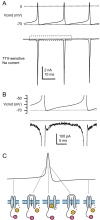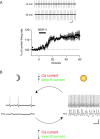The beat goes on: spontaneous firing in mammalian neuronal microcircuits
- PMID: 15496653
- PMCID: PMC6730100
- DOI: 10.1523/JNEUROSCI.3375-04.2004
The beat goes on: spontaneous firing in mammalian neuronal microcircuits
Figures


Similar articles
-
Intrinsic and synaptic plasticity in the vestibular system.Curr Opin Neurobiol. 2006 Aug;16(4):385-90. doi: 10.1016/j.conb.2006.06.012. Epub 2006 Jul 13. Curr Opin Neurobiol. 2006. PMID: 16842990 Review.
-
Inferior olive lesion induces long-term modifications of cerebellar inhibition on Deiters nuclei.Neurosci Res. 1986 Nov;4(1):51-61. doi: 10.1016/0168-0102(86)90016-7. Neurosci Res. 1986. PMID: 3808481
-
The origin of cerebellar-induced inhibition of deiters neurones. 3. Localization of the inhibitory zone.Exp Brain Res. 1968;4(4):310-20. doi: 10.1007/BF00235698. Exp Brain Res. 1968. PMID: 5712689 No abstract available.
-
Dogfish horizontal canal system: responses of primary afferent, vestibular and cerebellar neurons to rotational stimulation.Neuroscience. 1980;5(10):1761-9. doi: 10.1016/0306-4522(80)90093-7. Neuroscience. 1980. PMID: 7432620 No abstract available.
-
Cooperative functions of vestibular nuclei neurons and floccular Purkinje cells in the control of nystagmus slow phase velocity: single cell recordings and lesion studies in the monkey.Rev Oculomot Res. 1985;1:233-50. Rev Oculomot Res. 1985. PMID: 3940150 Review. No abstract available.
Cited by
-
I(A) channels encoded by Kv1.4 and Kv4.2 regulate neuronal firing in the suprachiasmatic nucleus and circadian rhythms in locomotor activity.J Neurosci. 2012 Jul 18;32(29):10045-52. doi: 10.1523/JNEUROSCI.0174-12.2012. J Neurosci. 2012. PMID: 22815518 Free PMC article.
-
Entropy considerations in improved circuits for a biologically-inspired random pulse computer.Sci Rep. 2022 Jan 7;12(1):115. doi: 10.1038/s41598-021-04177-9. Sci Rep. 2022. PMID: 34997140 Free PMC article.
-
Intrinsic oscillatory activity arising within the electrically coupled AII amacrine-ON cone bipolar cell network is driven by voltage-gated Na+ channels.J Physiol. 2012 May 15;590(10):2501-17. doi: 10.1113/jphysiol.2011.225060. Epub 2012 Mar 5. J Physiol. 2012. PMID: 22393249 Free PMC article.
-
Contributions of the Sodium Leak Channel NALCN to Pacemaking of Medial Ventral Tegmental Area and Substantia Nigra Dopaminergic Neurons.J Neurosci. 2023 Oct 11;43(41):6841-6853. doi: 10.1523/JNEUROSCI.0930-22.2023. Epub 2023 Aug 28. J Neurosci. 2023. PMID: 37640554 Free PMC article.
-
Long-term plasticity is proportional to theta-activity.PLoS One. 2009 Jun 9;4(6):e5850. doi: 10.1371/journal.pone.0005850. PLoS One. 2009. PMID: 19513114 Free PMC article.
References
-
- Bellamy TC, Garthwaite J (2001) “cAMP-specific” phosphodiesterase contributes to cGMP degradation in cerebellar cells exposed to nitric oxide. Mol Pharmacol 59: 54-61. - PubMed
-
- Bredt DS, Hwang PM, Snyder SH (1990) Localization of nitric oxide synthase indicating a neural role for nitric oxide. Nature 347: 768-770. - PubMed
Publication types
MeSH terms
LinkOut - more resources
Full Text Sources
